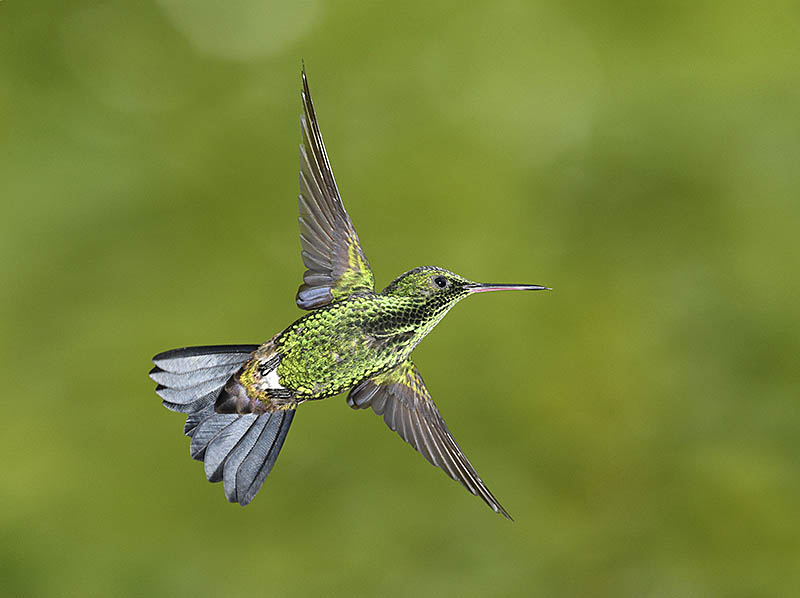8. Flash Photography
Flash is a potentially invaluable tool in a bird photographer’s armoury but its use seems to polarise opinions: some see the advantages it has to offer if used insightfully, but it also has its detractors who hate its perceived artificiality. In truth, using flash can produce some pretty ghastly, un-lifelike results if executed inappropriately. And it is probably not a technique to use in company, being viewed as antisocial by some. But if employed in a sympathetic manner its effects are positive, softening shadows and bringing out colours, contrast and feather detail in shady, dappled or poor-light conditions. And as anyone who has tried to photograph in a tropical rainforest or after dark will testify, there are some situations where, without flash, the creation of publishable quality images is not be possible.
Nocturnal species such as this Large-tailed Nightjar typically roost in the daytime in deep shade. The subtle use of flash allows their plumage colours and patterns to be fully appreciated. ©Paul Sterry/BPOTY
Under most lighting conditions, hummingbird plumage appears rather dull. The careful use of flash brings patterns of iridescence to life, as with this Ruby Topaz. ©Paul Sterry/BPOTY
a. Fill-in flash and modelling
Most photographers would agree that under ideal circumstances natural light produces the best results. The problem is that the best natural light – arguably early morning or late afternoon low-level sunlight - is limited in duration and often in short supply because of the weather. The subtle use of flash as fill-in or to produce a modelling effect offers the photographer extends opportunities to replicate the effects of perfect natural lighting.
The key to using fill-in flash successfully is to harmoniously balance ambient natural light and flash, the result being an image where it is not immediately obvious that anything other than natural lighting has been used. It is a bit like make-up: if you can see it has been used then probably too much has been applied. Consequently, subtlety is the watchword.
Assuming you want to use flash in a field context, and not as part of a studio set-up, then you will probably need a moderately powerful flash unit – one with a guide number of around 30 perhaps; a flash’s guide number is a measure of its output power. Extender units with Fresnel lenses can be used to extend the operational range. The default shutter speed for flash synchronisation with camera shutter is typically 1/250th second or 1/320th second. But many digital SLRs have a high-speed flash synchronisation aperture as well, typically buried deep inside the camera’s menu.
: Nightingales often sing from deep cover, where shady lighting makes doing them photographic justice a challenge. Fill-in flash can help soften shadows, and increase contrast revealing greater feather detail. ©Paul Sterry/BPOTY
b. Hummingbirds
Hummingbirds occur exclusively in the New World and some dedicated enthusiasts devote their lives to capturing images of these amazing birds. From a photographic point of view, hummingbirds offer some real advantages as subjects but provide a range of challenges too. On the plus side, most species can be attracted with relative ease to sugar-water feeders; when visiting feeders they often follow a predictable flight path; typically they hover while feeding (giving autofocus a chance to work); and hummingbirds are often indifferent to people if they sit still. On the negative side their flight is fast and in particular their wings beat at phenomenon speeds – on average 50 times a second in normal flight with most species. And the stunning ‘colours’ for which most species are known are the result of reflective qualities of their feathers not true colours; in natural light they are only visible at precise, limited angles and often it is only by using flash that their splendour is revealed. Furthermore there is the size factor: most species are tiny, many tropical species being dwarfed by some insects with which they share their environment.
In the past, hummingbird flight photography was a specialist pursuit requiring at least three flash units and often modifications to the cameras themselves. Today, it is much more straightforward. In certain circumstances, by using high ISO values natural light can be sufficient to capture the movement, especially with larger species whose wingbeats are slower. But high-speed flash synchronisation can also be used to good effect using a single flash unit. To avoid a dark background, try photographing into the light, or ensuring the background is brightly lit, while lighting the hummingbird using flash.
Captured with its wings spread, this Copper-rumped Hummingbird was photographed using a single flash unit, high-speed flash sync, and ambient light illuminating the natural background. ©Paul Sterry/BPOTY
c. After dark
Modern digital cameras are capable of functioning at extraordinarily high ISO values, so much so that images can be taken by moonlight. But if you are a discerning bird photographer the results are usually no more than a novelty and some form of artificial light in the form of flash provides the best chances of getting decent shots. Bear in mind that if your subjects are nocturnal birds then their eyes will be very sensitive to light, so keep your flash output to a minimum and be aware of any distress you might be causing: you must not risk temporarily blinding your subject.
Being able to photograph a Nightjar, in flight and at night, is perhaps the ultimate testament to the technology of current generation digital cameras and autofocus lenses. ©Paul Sterry/BPOTY





